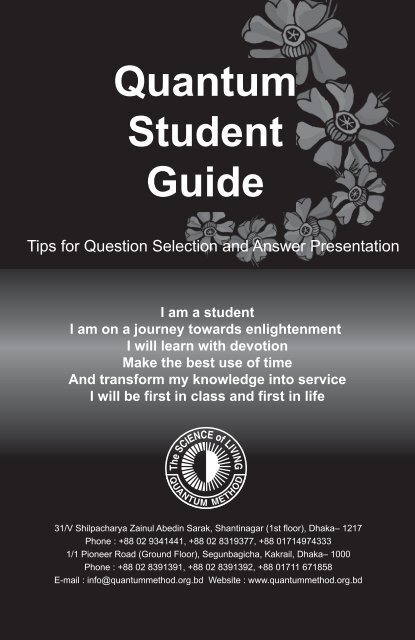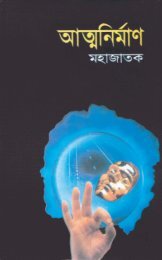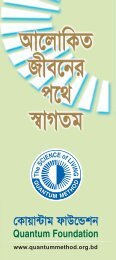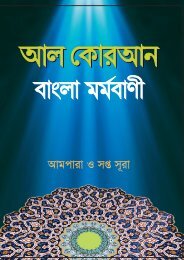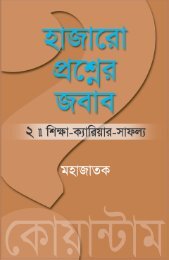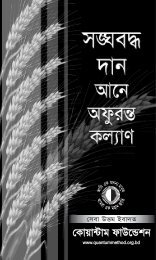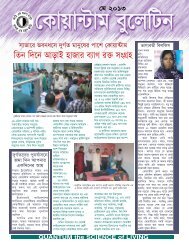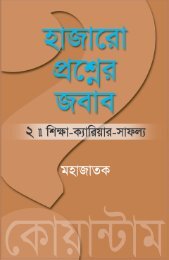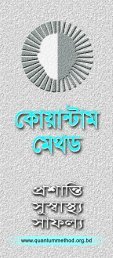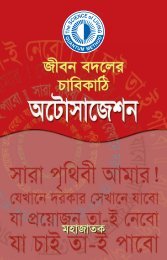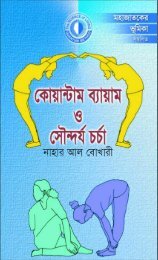Student guide.pdf - Quantum Method
Student guide.pdf - Quantum Method
Student guide.pdf - Quantum Method
Create successful ePaper yourself
Turn your PDF publications into a flip-book with our unique Google optimized e-Paper software.
<strong>Quantum</strong><br />
<strong>Student</strong><br />
Guide<br />
Tips for Question Selection and Answer Presentation<br />
I am a student<br />
I am on a journey towards enlightenment<br />
I will learn with devotion<br />
Make the best use of time<br />
And transform my knowledge into service<br />
I will be first in class and first in life<br />
31/V Shilpacharya Zainul Abedin Sarak, Shantinagar (1st floor), Dhaka– 1217<br />
Phone : +88 02 9341441, +88 02 8319377, +88 01714974333<br />
1/1 Pioneer Road (Ground Floor), Segunbagicha, Kakrail, Dhaka– 1000<br />
Phone : +88 02 8391391, +88 02 8391392, +88 01711 671858<br />
E-mail : info@quantummethod.org.bd Website : www.quantummethod.org.bd
After You Get the Question Paper:<br />
1. Figure out how much time you have for answering each question. Divide the<br />
total time of the examination by the number of questions you need to answer. Then<br />
set aside 3 or 4 minutes per question for revision. This will tell you how much time<br />
you have to actually write the answers. For example, if you have to answer 5<br />
questions in 3 hours or 180 minutes, you will get 180/5, or 36 minutes to answer<br />
each question. Try to complete each answer within 32 minutes. Keep the last 20<br />
minutes of the exam for revision.<br />
[This is a general rule. Sometimes, instead of keeping equal time for each question<br />
you may need to keep more time for the complicated questions and less time for<br />
the simpler ones.]<br />
2. After you get the question paper, go through it a number of times. Make sure<br />
you check both sides of the paper. Find out how many questions you have to<br />
answer. Then mark the questions you want to answer. When you have finished<br />
answering a question put another mark on it. The double marks will be easier to<br />
notice and tell you which questions you have already answered.<br />
3. When deciding which questions to answer, consider which answers you know<br />
better; also take a look at the distribution of marks. Usually it is easier to get more<br />
marks when a question is divided into two or more smaller parts. For instance, you<br />
will probably get more marks if you answer question no. 2 or 3 instead of question<br />
no.1 in the following example.<br />
1. Explain how the urban land use pattern has developed. 4<br />
2. a) Give two advantages of using the power of the wind to make electricity. 2<br />
b) Give two disadvantages of using the power of the wind to make electricity. 2<br />
3. For each of the following, describe two factors that can cause inequalities in<br />
development: 2*2<br />
• Economic<br />
• Social<br />
4. Read the question you are about to answer carefully. Make sure you<br />
understand exactly what it is asking for. Pay special attention to words or phrases<br />
such as ‘define’, ‘describe’, ‘explain’, ‘analyze’, ‘compare’, ‘contrast’ , ‘comment’,<br />
‘give your opinion on’, ‘describe the significance of’ etc. For each of these the<br />
answer will be different. Plan your answer based on the question. Do ‘answer<br />
mapping’, i.e. plan how you will answer each type of question, beforehand.<br />
5. Make sure you do not take so much time for one answer that you do not have<br />
time for others. Two answers, even if they are short, usually bring more marks than<br />
one, no matter how detailed it is. Answer all compulsory questions, even if you have<br />
to improvise. If the last question has a theoretical and a mathematical part, and you<br />
know both the answers but time is running out, answer the mathematical part first,<br />
and then the theoretical part. [This will depend on the distribution of marks.]
Presenting Answers in an Attractive Way:<br />
1. Instead of folding the edges of the answer sheet draw a margin with a ruler. Use<br />
a pencil for drawing the margin. Keep a margin of one inch, or the width of a normal<br />
ruler, on top and left. You can also draw margins on all four sides, but this may<br />
leave too little space for writing. You may make the left margin slightly wider. This<br />
will ensure that your writing is visible even if you need to staple extra paper. If you<br />
don’t have time to draw<br />
margins on the extra<br />
sheets, fold the edges. If<br />
you are taking an exam in<br />
Accounting, draw margins<br />
Normal Margin<br />
only for the theoretical<br />
Square Margin<br />
parts. Since journals and<br />
ledgers have their own<br />
Type 1: Normal Margin Type 2: Square Margin<br />
tables, there is little scope<br />
for drawing margins on the<br />
whole sheet.<br />
2. If an answer takes more than one page, instead<br />
of writing to the very end of the page keep at least<br />
half an inch empty at the bottom.<br />
3. If your answer takes more than one page, simply<br />
write P.T.O (abbreviation of Please Turn Over) at<br />
the bottom right of the page. It is better to avoid<br />
drawing an arrow ( ) instead of writing P.T.O.<br />
Numbering each page is also unnecessary.<br />
P.T.O<br />
Leave this much space empty<br />
4. When deciding the order in which to answer the questions follow the 'SLGS'<br />
method: S=Solid, L=Liquid, G=Gas, S=Solid. Start with a solid, i.e. an answer you<br />
know very well. Then write a liquid, i.e. an answer you know well, but not as well as<br />
a solid. Then move on to gas, an answer you know less well than a liquid. Then<br />
finish with another solid, an answer you know very well.<br />
5. Suppose you need to answer 4 out of 6 questions and questions 2 and 4 are<br />
‘solids’ for you, i.e. you know them best. Then according to the 'SLGS' formula, you<br />
should start with either one of them. You may then decide to answer question 1<br />
because it is a ‘liquid’ for you and follow it with question 6 because it is a ‘gas’ for<br />
you. You may also decide the order among the solids. For example, say both 2 and<br />
4 are solids for you, but you know 4 better than 2. Then start with number 4. Then<br />
the order would be 4, 1, 6 and 2.
6. If there are sub-questions within the questions, for instance, a, b, c etc., follow<br />
the order given. For example, if question 4 has parts a, b and c to be answered,<br />
then start with 4a, followed by 4b and 4c. If you think you can answer a and c very<br />
well but you need some time to think about b, then leave the required space for b<br />
and finish answering others. Come back to b later.<br />
Answer to Question No. 4(A)<br />
Answer to Question No. 4(B)<br />
Answer to Question No. 4(C)<br />
In other words, answer related questions in a sequence. Don’t change the order or<br />
break them apart. For example, do not write 1a, 1b, and 1c between 4a and 4b. If<br />
there are some parts that you need to think about, leave space for them, finish the<br />
rest and come back to them at the end. Leave the amount of space you think the<br />
answer will require.<br />
7. Write the number of the question clearly. If your answer covers more than one<br />
page you do not need to write the question number on each page. Before you start<br />
answering a question, write ‘Answer to question no-X' in the middle of the page.<br />
Use a straight line [ ] instead of curves [ ] for underlining.<br />
8. For ‘answer in a one word’, ‘fill in the blanks’, ‘true/false’ or ‘match and join’ type<br />
questions, write a, b, c / i, ii, iii etc. on the left margin.<br />
9. Leave some breathing space between two answers. Follow these general rules<br />
with regard to spacing:<br />
● If one answer<br />
covers one third<br />
or less of a page,<br />
leave about 2’’<br />
and start the next<br />
answer.<br />
● If one answer<br />
covers half or two<br />
thirds of a page<br />
then start the next answer from the next page.<br />
Answer to Question No.2(B)<br />
In such cases start the next<br />
answer from the next page<br />
Start from a new page when you are answering a completely new question. But<br />
take care not to leave any page completely blank.
10. You may answer ‘fill in the blanks’, ‘true/ false’, and other very short questions<br />
in the beginning. Then you can move on to the medium sized answers and end with<br />
the descriptive ones. In Accounting exam you can answer the theoretical questions<br />
quickly and then do the math. If the theory and the math are parts of the same<br />
question then leave enough space for the math.<br />
11. Leave a half inch gap at the<br />
end of a question and then draw<br />
a closing sign. The closing sign<br />
should be a straight line like this<br />
[ ________ ], not [ 0 ] or<br />
[ X ].<br />
Leave<br />
one inch<br />
on the left<br />
when you<br />
start after<br />
the title<br />
Answer to Question No. 2(A)<br />
12. Use black ballpoint pens for<br />
exams unless you are told<br />
otherwise. You may use a blue ballpoint pen to write short titles such as ‘examples’,<br />
‘benefits’ or 'Answer to question no 1'. You can use black, blue or light blue sign<br />
pens for underlining. But make sure you avoid green, orange, red, yellow or any<br />
fluorescent colors during an exam. If you want to highlight a word or sentence in the<br />
answer underline it with the black ballpoint. It is better not to use gel pens because<br />
the ink often spreads and makes a mess.<br />
13. When you are taking a math exam spare one or two pages at the end for doing<br />
rough calculations. Make sure you write the question number properly before you do<br />
the rough work for a particular question. Once all the rough work is done cross it out<br />
with a single line. You can also do the rough work on the page where you are writing<br />
the answer, creating a column by drawing a vertical line at the right side of the page.<br />
In either case, write ‘rough’ on top. However, having the rough work on the same<br />
page as the problems not only lessens the beauty of your copy, but also reduces<br />
space for solving the problems.<br />
14. Write the final answer to the math problem in a box, like this: Answer: 500<br />
Write (approximately) next to an approximate answer. After proving a theorem, write<br />
‘proved’ within brackets like this: (proved).<br />
15. If you have to write a poem, start and finish it in the same page. Make sure you<br />
write the name of the poet along with the title of the poem. Take care to spell the<br />
names of the poets and authors correctly.<br />
16. Good handwriting is always a bonus for students. Make sure your handwriting<br />
is clearly legible. Be careful when writing ‘r’, ‘x’, and ‘n’ in mathematics exams.<br />
Leave a moderate amount of space between two lines, neither too much nor too<br />
little. Make sure your letters aren’t too big.
For High Quality Answers:<br />
1. The length of the answer should depend on the type of the question, and the<br />
time and marks allocated to it. For instance, say you expected a question to carry 10<br />
marks and prepared accordingly. But in the exam you find that only 5 marks have<br />
been allocated to it. Cut the size of the answer down to half. Similarly, when you are<br />
preparing the answer for a question you expect to carry 5 marks, think of how you<br />
can expand the answer in case it carries 7 or 10 marks. Do not repeat any information.<br />
Write only what is asked for. Do not write anything that is unnecessary or<br />
irrelevant, or anything that is hard to understand. For technical or mathematical<br />
questions, answer as required.<br />
2. Write an introduction and a conclusion for descriptive questions, but make sure<br />
they are not too long. For example, if the question is ‘Describe the functions of the<br />
state', you may start with a definition of the state and then move on to its functions.<br />
You can begin your concluding paragraph with the phrase ‘in conclusion’.<br />
3. Write the introduction, main body, and conclusion in separate paragraphs. You<br />
can split the main body into several paragraphs dealing with different topics. If a<br />
question has several parts then write the answer to each part in separate<br />
paragraphs.<br />
4. You can use small headings such as ‘method’, ‘example’, ‘benefit’, ‘advantages’<br />
etc in your answer. But never write ‘introduction’, ‘main body’ and ‘conclusion’ as<br />
titles.<br />
5. Answer in points whenever you can. Instead of using an asterix (*) to mark the<br />
points, use digits (1, 2, 3), alphabets (a, b, c) etc. If the questions or sub questions<br />
are marked 1, 2, 3 or a, b, c use the roman numerals [i, ii, iii,] or bullets such as [<br />
or or ] instead.<br />
6. Use relevant tables, charts, and diagrams to support your answers. You can also<br />
use quotations and add appropriate examples depending on the question. In the<br />
social science exam, alongside maps and solar systems, add diagrams whenever<br />
possible. When relevant, add quotes in other languages, such as Arabic verses in<br />
the Islamic Studies and Sanskrit verses in Hindu Studies.<br />
7. In a science exam, use diagrams or pictures with as many answers as possible.<br />
Use a sharp pencil to draw the picture. Use the following format while drawing the<br />
picture:<br />
Draw a box with a pencil like this.<br />
Draw the picture or diagram with a pencil inside the box.<br />
Label the diagram. Draw an arrow on the left side of the line as shown.<br />
Picture: Amoeba: (should be written with a pen)<br />
[Sometimes in the textbooks you may see a number such as 10.2 below a picture. This simply means that<br />
this is the 2nd diagram in the 10th chapter. You don’t need to write this number in your exam.]
8. In questions where diagrams are compulsory, draw the diagram right at the<br />
beginning or after a short introduction and then write the main body. If you are<br />
running short of time cut down the descriptive part if necessary, but make sure you<br />
draw the diagram.<br />
9. Start geometry<br />
answers (such as<br />
proving theorems<br />
etc.) from the left<br />
page and finish<br />
them in the right<br />
page. If you have to<br />
turn to the next<br />
page, draw the diagram again.<br />
Answer to Question No. 3(A)<br />
Given:<br />
diagram<br />
Support:<br />
(Proved)<br />
10. Use tables to show differences. The table should be like the following:<br />
Sl. No. Subject Heat Temperature<br />
1<br />
Definition<br />
Heat is a form of energy.<br />
Temperature is the heated<br />
state of any substance.<br />
2<br />
3<br />
Measuring instrument<br />
Measuring unit<br />
The apparatus for measuring<br />
heat is called calorimeter.<br />
The CGS unit of measuring heat is<br />
Calorie. In SI unit, it is Joule.<br />
The apparatus for measuring<br />
temperature is called thermometer.<br />
The CGS unit of measuring<br />
temperature is degree Celsius.<br />
In SI unit, it is Kelvin.<br />
- draw the table with a pencil<br />
- ‘subject’ means in what aspect the two things are different . This is the essence of<br />
the main point.<br />
- You can use a blue ballpoint pen to highlight the headings (in this case serial no,<br />
topic, heat and temperature).<br />
11. Be careful about correct spelling. In some cases there may even be spelling<br />
mistakes in the textbooks. When in doubt take the help of a good dictionary.<br />
12. Avoid crossing out and overwriting as much as possible. Instead of overwriting,<br />
write afresh whenever you can. If you need to cross out something, use a single line.<br />
If space allows, write the correct word next to it. Otherwise use an arrow sign and<br />
write above the line like this:<br />
Instead of overwriting like this<br />
cross it out and write afresh.<br />
3<br />
Not like this:<br />
To be, or not too be that is the question. /to<br />
Like this: to<br />
To be or not too ^ be, that is the question.<br />
To be or not too /to be, that is the question.
Others<br />
1. When revising make sure you haven’t left out any questions. Pay special<br />
attention to name, roll no., registration no., mathematical formulas and symbols,<br />
calculations, spelling, sentence structure, punctuation, question no. etc.<br />
2. Do not do rough work above the margin or on the question paper. Try not to write<br />
any formulas or hints to answers on the question paper.<br />
3. Organize the essential things, such as several black ballpoint pens, sign pens<br />
/markers, pencil, eraser, sharpener, calculator, compass, ruler, wrist watch (it is<br />
better to set the time 5 minutes ahead) the night before the exam.<br />
4. If you need more than one extra sheet, number them as 1, 2, 3 etc. Write your<br />
name, roll no, or code no. on the extra sheets according to the exam instructions.<br />
This way the extra sheets can be identified even if they become unattached. Ask the<br />
invigilators what reference information to write on the extra sheets if OMR sheets<br />
are involved.<br />
5. Rather than leaving the seat again and again, keep two to three extra sheets<br />
with you at a time with the invigilator's permission.<br />
6. If you have to use a thread to bind the extra sheets, make sure you bind tightly. If<br />
you are using a stapler, staple both ends of the length from both sides, not the<br />
middle.<br />
7. If there are several sets of questions, such as in objective exams (MCQ), write<br />
the correct set code on the script. After answering the objective questions match the<br />
answers with the questions properly to ensure that all questions have been<br />
answered.<br />
8. Use black ballpoint pens to fill up the circles. Start filling up from the periphery<br />
and gradually come to the centre.<br />
9. Check carefully for special instructions on the admit card and registration card.<br />
Dear <strong>Student</strong>,<br />
You know, exams are excellent opportunities to demonstrate your skills and abilities<br />
to the examiner. And the examiner’s impression of you is based on your answer<br />
script. The <strong>guide</strong>lines above will just help you create a positive impression in the<br />
examiner’s mind. You will get many more tips that will help you succeed in student<br />
life in our three part konica series ‘shofol shikharthi’.<br />
If you have any comments or questions about this <strong>guide</strong>book, please send them to:<br />
Moderator<br />
<strong>Student</strong> Program<br />
<strong>Quantum</strong> Foundation<br />
Email: student@quantummethod.org.bd


